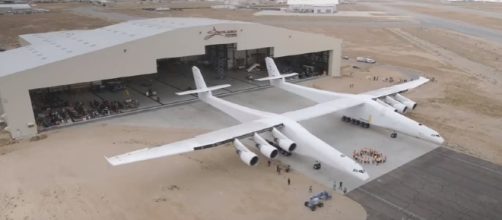Microsoft co-founder and billionaire Paul G. Allen has been busying himself with a great number of endeavors. There’s his advocacy for African elephants to keep them safe from stubborn ivory hunters. Then there’s his private company Vulcan Inc., in particular, its Vulcan Aerospace division and its subsidiary Stratolaunch Systems.
Fox News report that this project aims to design a working air launch vehicle for spacecraft, essentially a big aircraft to launch space vehicles off in the upper atmosphere. And we’re talking really big here. Paul Allen’s Stratolaunch aircraft is angling to be the largest airplane in the world where wingspan is concerned.
When the first vehicle finally rolled out of the hangar on the last day of May, one could easily agree.
Massive airframe
May 31 saw the public debut of the Stratolaunch Systems Scaled Composites Model 351 spacecraft air launch vehicle. It’s a real mouthful, so Paul Allen’s space transport development venture opts to call it the “Roc” carrier aircraft but the media for the moment, prefers to refer to the massive aircraft by its developers’ name. The air launch vehicle is indeed humongous, nearly occupying all the space in its hangar over at the Stratolaunch Systems hangar in Mojave, California.
The design of the Stratolaunch certainly draws a lot of attention. It’s actually two aircraft fuselages lying parallel to each other and connected by a wing with the largest span ever on any aircraft in history.
It’s an amazing 385 feet across, with six 747-class jet engines in all. None of the largest commercial aircraft from Boeing or Airbus can match it. Only Howard Hughes’ “Spruce Goose” comes close, and its wingspan falls short at just 320 feet. Meanwhile, the twin fuselages are an identical 285 feet long. In its role as an air launch platform for space rockets and shuttles, it can take off at a max 1.3 million pounds of weight.
Air launch
Regarding the purpose for which the Stratolaunch Air Carrier was built, it works by carrying any rocket or spacecraft it will launch in the center portion of its giant wing, positioned between the two fuselages. Up to three rockets can fit in that space. Once the Stratolaunch has flown up to the stratosphere, the rockets are released and ignited, whereupon they the carry satellites on up into space.
The genius of this system as Paul Allen sees it, is that the air carrier can be deployed to launch from any airport with a large-enough runway, rather than relying on dedicated space launching sites which are limited in number. The public will have to wait a while for more though. Stratolaunch will only perform ground tests at first, with its first test rocket launch schedule for 2019.


